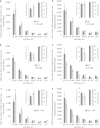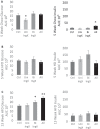Subcutaneous adipose tissue accumulation protects systemic glucose tolerance and muscle metabolism
- PMID: 30230416
- PMCID: PMC6768251
- DOI: 10.1080/21623945.2018.1525252
Subcutaneous adipose tissue accumulation protects systemic glucose tolerance and muscle metabolism
Abstract
The protective effects of lower body subcutaneous adiposity are linked to the depot functioning as a "metabolic sink" receiving and sequestering excess lipid. This postulate, however, is based on indirect evidence. Mechanisms that mediate this protection are unknown. Here we directly examined this with progressive subcutaneous adipose tissue removal. Ad libitum chow fed mice underwent sham surgery, unilateral or bilateral removal of inguinal adipose tissue or bilateral removal of both inguinal and dorsal adipose tissue. Subsequently mice were separated into 5 week chow or 5 or 13 week HFD groups (N = 10 per group). Primary outcome measures included adipocyte distribution, muscle and liver triglycerides, glucose tolerance, circulating adipocytokines and muscle insulin sensitivity. Subcutaneous adipose tissue removal caused lipid accumulation in femoral muscle proximal to excision, however, lipid accumulation was not proportionally inverse to adipose tissue quantity excised. Accumulative adipose removal was associated with an incremental reduction in systemic glucose tolerance in 13 week HFD mice. Although insulin-stimulated pAkt/Akt did not progressively decrease among surgery groups following 13 weeks of HFD, there was a suppressed pAkt/Akt response in the non-insulin stimulated (saline-injected) 13 week HFD mice. Hence, increases in lower body subcutaneous adipose removal resulted in incremental decreases in the effectiveness of basal insulin sensitivity of femoral muscle. The current data supports that the subcutaneous depot protects systemic glucose homeostasis while also protecting proximal muscle from metabolic dysregulation and lipid accumulation. Removal of the "metabolic sink" likely leads to glucose intolerance because of decreased storage space for glucose and/or lipids.
Keywords: adipose tissue distribution; lipectomy; metabolic sink; muscle; subcutaneous adipose tissue; triglyceride; visceral adipose tissue.
Figures




Similar articles
-
Lower body adipose tissue removal decreases glucose tolerance and insulin sensitivity in mice with exposure to high fat diet.Adipocyte. 2014 Dec 20;4(1):32-43. doi: 10.4161/21623945.2014.957988. eCollection 2015 Jan-Mar. Adipocyte. 2014. PMID: 26167400 Free PMC article.
-
Peripancreatic adipose tissue protects against high-fat-diet-induced hepatic steatosis and insulin resistance in mice.Int J Obes (Lond). 2020 Nov;44(11):2323-2334. doi: 10.1038/s41366-020-00657-6. Epub 2020 Aug 25. Int J Obes (Lond). 2020. PMID: 32843711 Free PMC article.
-
Enhanced lipid oxidation and maintenance of muscle insulin sensitivity despite glucose intolerance in a diet-induced obesity mouse model.PLoS One. 2013 Aug 12;8(8):e71747. doi: 10.1371/journal.pone.0071747. eCollection 2013. PLoS One. 2013. PMID: 23951235 Free PMC article.
-
Differential effect of subcutaneous abdominal and visceral adipose tissue on cardiometabolic risk.Horm Mol Biol Clin Investig. 2018 Mar 9;33(1). doi: 10.1515/hmbci-2018-0014. Horm Mol Biol Clin Investig. 2018. PMID: 29522417 Review.
-
Role of subcutaneous adipose tissue in the pathogenesis of insulin resistance.J Obes. 2013;2013:489187. doi: 10.1155/2013/489187. Epub 2013 Apr 4. J Obes. 2013. PMID: 23691287 Free PMC article. Review.
Cited by
-
Goat miR-92a-3p Targets APOL6 Gene to Regulate the Differentiation of Intramuscular Precursor Adipocytes.Genes (Basel). 2023 Dec 30;15(1):57. doi: 10.3390/genes15010057. Genes (Basel). 2023. PMID: 38254947 Free PMC article.
-
Progranulin: A proangiogenic factor in visceral adipose tissue in tumoral and non-tumoral visceral pathology.Exp Ther Med. 2021 Nov;22(5):1337. doi: 10.3892/etm.2021.10772. Epub 2021 Sep 22. Exp Ther Med. 2021. PMID: 34630691 Free PMC article.
-
The Effect of Chronic Laxative Use on Lipid Profile and HbA1c: A Hospital-Based Retrospective Study.Cureus. 2023 Sep 11;15(9):e45055. doi: 10.7759/cureus.45055. eCollection 2023 Sep. Cureus. 2023. PMID: 37829969 Free PMC article.
-
HMB Improves Lipid Metabolism of Bama Xiang Mini-Pigs via Modulating the Bacteroidetes-Acetic Acid-AMPKα Axis.Front Microbiol. 2021 Aug 16;12:736997. doi: 10.3389/fmicb.2021.736997. eCollection 2021. Front Microbiol. 2021. PMID: 34484171 Free PMC article.
-
Visceral adipose tissue alteration of PI3KR1 expression is associated with gestational diabetes but not promoter DNA methylation.Adipocyte. 2019 Dec;8(1):339-346. doi: 10.1080/21623945.2019.1675239. Adipocyte. 2019. PMID: 31608772 Free PMC article.
References
-
- Ogden CL, Carroll MD.. Prevalence of overweight, obesity, and extreme obesity among adults: United States, trends 1960–1962 through 2007–2008. National Center for Health Statistics. 2010;6(1):1–6.
-
- Kopelman PG. Obesity as a medical problem. Nature. 2000;404(6778):635–643. - PubMed
-
- Brown CD, Higgins M, Donato KA, Rohde FC, Garrison R, Obarzanek E, Ernst ND, Horan M. Body mass index and the prevalence of hypertension and dyslipidemia. Obes Res. 2000;8(9):605–619. - PubMed
-
- Sims EA. Are there persons who are obese, but metabolically healthy? Metabolism. 2001;50(12):1499–1504. - PubMed
-
- Reaven GM. Importance of identifying the overweight patient who will benefit the most by losing weight. Ann Intern Med. 2003;138(5):420–423. - PubMed
Publication types
MeSH terms
Substances
Grants and funding
LinkOut - more resources
Full Text Sources
Other Literature Sources
